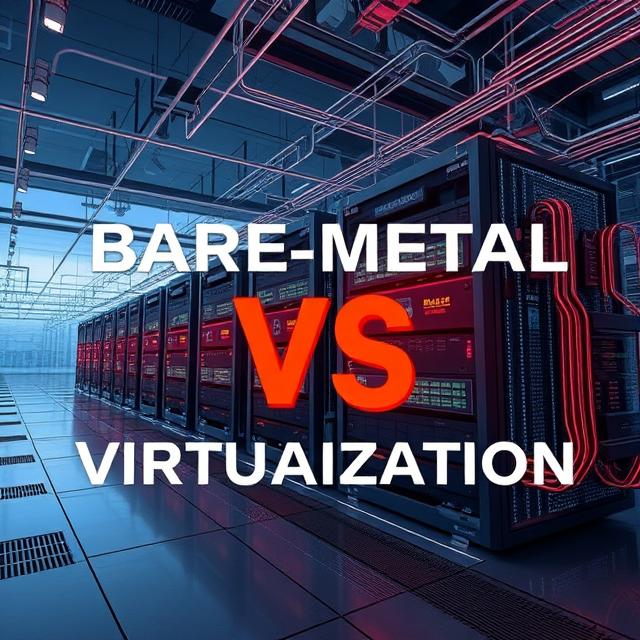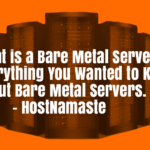
Bare-Metal vs Virtualization : What Performs Better?
For years, both Bare-metal servers and virtualization have dominated the IT industry. Virtualization was introduced way back in the 60s when owning such technology was quite expensive. Before that, organizations only knew one way to access the servers; by keeping them on the premises.
Then came virtualization and people were given a choice between bare-metal, in which the servers were optimized by a single tenant and kept on-premises; and Virtualization, which is an online service and shared by other users. Over the decades, all of us IT enthusiasts have witnessed virtualization prices going down a notch. Bare-metal servers have also witnessed an increase in technology and a decrease in the price.
Either one of these is easily affordable by companies all over the world nowadays. Gone are the days when you had to pay a fortune to purchase bare-metal servers or virtualization services.
However, there’s still an ongoing debate that has been running for decades surrounding the superiority of each of these services. It’s rather challenging to point at either bare-metal or a cloud solution and decide that one more beneficial than the other. Both are quite powerful and have been declared superlative in the opinions of several different people.
You can opt for them as per your organizational or individual requirements and you cannot do so without considering plus points and negatives ones of both bare-metal and virtualization cloud solutions.
This article is fabricated so we could narrow down the advantages and deficiencies of bare-metal servers and virtualization so you can decide which one would be best suitable for you based on each of their performance and reliability.
So, here it goes. Let’s get started to know the Pros and Cons of both:
Pros of using bare-metal
1) Single-tenant environment
A bare-metal server is a ‘single-tenant’ physical server. This states that only one customer or one company has remote access to this server and no other user has the permission to utilize it or access it in any way. If you’re using a bare-metal server, you have the entire authority over it around-the-clock. Frankly speaking, it’s kind of pleasing to be aware that all of the resources could be accessed by you at any given time and in case an inconvenience happens, you can easily sort it out yourself without requiring permission from the hypervisor.
Having a single-user environment also prevents lags or system failures happening because of other users sharing the same server space and resources.
2) Powerful and takes more load
Bare-metal servers are especially preferred by those who are more prone to run heavy applications and extensive databases. If you go with virtual servers, then because other servers also share the same space, your applications may not perform as brilliantly as they would in an isolated server.
3) Advanced security
As far as security is concerned, bare-metal is far superior to virtualized environments and cloud as you are the single tenant on the server.
Cons of using bare-metal
1) Cost
If you go for a virtual private server, it is bound to cost less than it would for bare-metal ones. Bare-metal are servers that are acquired by a single customer whereas a virtualized environment has numerous tenants per server.
Pros of using Virtualization
1) Inexpensive
The cost of virtualization gradually decreased over the years. The expenses are usually shared among other users sharing the same server.
Since you only pay for your acquired space in the virtual machine, it’s bound to cost you less and you can effectively save your money for other important expenses of your company.
2) Instant activation
One of the best things about opting for virtualization is the activation. Virtualized solutions operate online and are emulated machines, which means that virtual machines are an emulation of a computer system that behaves like a separate computer but isn’t one. Activating a VM takes mere seconds.
3) Migration is convenient
Another one of virtualization’s pros is its ability to migrate and manage the database so conveniently. If you want to switch to a new VM, you can so do without much of a hassle. In bare-metal servers, migration can be a more difficult task.
Not just migration, you can even add new VM’s and just move your database around without the risk of anything being misplaced.
Cons of using Virtualization
1) Reduced Security
Because multiple users share the same server space and utilize the same resources as you do, it could cause your applications to run sluggishly. In addition to that, if one of the users causes an inconvenience of any sort, it could easily affect the performance of other users on the same server.
2) Limited Virtualization
Virtualization is not limitless. This means that not every application that you may want to run will support the virtualized environment. The sad truth is, not all servers and applications are virtualization-friendly. To run those specific apps, you might need to acquire additional resources and that could cost you some extra money.
Conclusion
In conclusion, both bare-metal servers and virtualization technologies can be suitable for you. You should, however, always choose the one that fits well with your organizational goals.
If you don’t have a problem with sharing server space with other tenants and don’t want an expensive solution, Virtualization is the right choice.
If, however, you wish to run heavy applications and want a powerful server, bare-metal is a desirable fix. It gives you complete authority and enhanced security over your servers.
If you need any assistance choosing the right server for you HostNamaste’s sales team is here to help and can be reached here.



